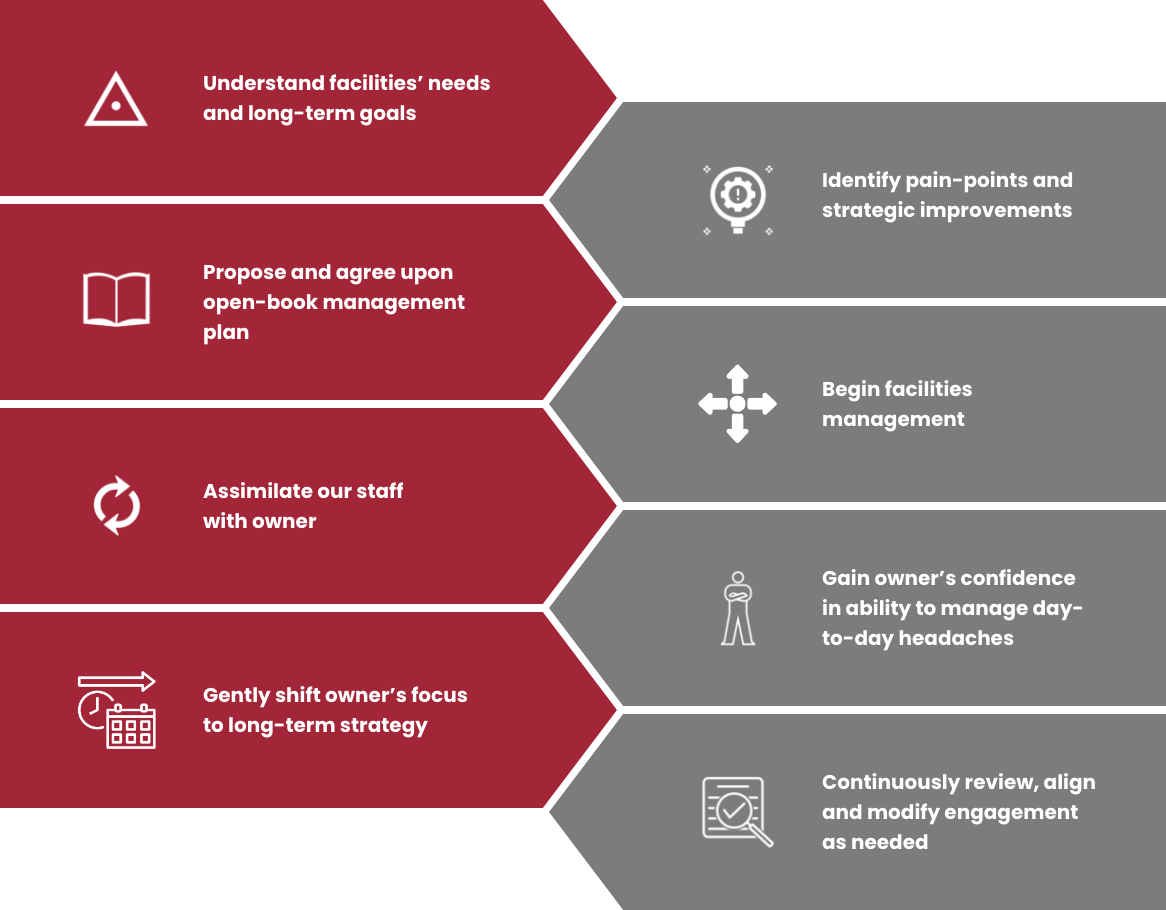Facility Management-- Streamlined Operations and Cost Savings
Wiki Article
Secret Fads Shaping the Future of Center Management in 2024
As we look in advance to 2024, the landscape of center monitoring is positioned for substantial transformation, driven by several crucial trends. The integration of smart structure modern technologies and a change in the direction of data-driven decision-making pledge to improve functional effectiveness while prioritizing sustainability in practice.Smart Structure Technologies

Smart structure innovations incorporate a broad variety of systems, consisting of intelligent illumination, HVAC controls, and safety systems. By incorporating these systems, facility managers can keep an eye on and readjust parameters in real-time, resulting in considerable decreases in power waste and operational costs. Clever sensing units can spot tenancy levels and adjust lights and temperature as necessary, guaranteeing that power is only used when required.
Furthermore, these innovations assist in improved information collection, enabling organizations to track usage patterns and determine opportunities for further improvements. The execution of clever structure modern technologies not just adds to sustainability objectives however likewise produces healthier workplace that can improve worker efficiency and contentment.
As we relocate into 2024, the adoption of smart building innovations will likely speed up, reflecting a broader change in the direction of more smart, responsive, and sustainable center monitoring techniques.
Data-Driven Choice Making
Increasingly, organizations are leveraging data-driven decision making to boost center administration techniques. By taking advantage of information analytics, center managers can derive workable understandings that significantly boost functional effectiveness and resource appropriation. The combination of advanced modern technologies, such as IoT sensing units and real-time monitoring systems, allows the collection of large quantities of information on building performance, tenancy rates, and energy consumption.This riches of information enables facility managers to recognize patterns, forecast maintenance demands, and proactively address issues prior to they escalate. Predictive analytics can anticipate tools failings, reducing downtime and repair service prices. In addition, information visualization tools assist in far better interaction amongst stakeholders, ensuring that notified decisions are made collaboratively.
Additionally, data-driven approaches improve critical planning by enabling center managers to evaluate the efficiency of existing practices and make informed options regarding investments in modern technology or facilities. As companies increasingly prioritize functional quality, data-driven decision making is poised to become a cornerstone of successful center administration methods in 2024 and past. Inevitably, the capability to take advantage of data properly will empower organizations to produce a lot more efficient, productive, and resilient facilities.
Sustainability and Eco-friendly Practices
The emphasis on data-driven choice making naturally aligns with the expanding concentrate on sustainability and environment-friendly methods within center management. As organizations increasingly focus on environmental duty, facility supervisors are leveraging analytics to enhance source usage, minimize waste, and decrease carbon footprints. This critical approach allows the assimilation of energy-efficient systems, such as LED lighting, wise heating and cooling controls, and eco-friendly energy sources into center procedures.Furthermore, the execution of lasting practices prolongs past energy usage. Facility managers are promoting and taking on environment-friendly products reusing initiatives to develop a circular economic situation within their facilities. This not just enhances the ecological account of the organization yet also cultivates a culture of sustainability amongst employees.
Compliance with ecological top article policies is an additional crucial facet driving the adoption of environment-friendly practices. By using information analytics, facility supervisors can monitor conformity metrics and identify locations for renovation, guaranteeing adherence to neighborhood and international sustainability requirements.
Crossbreed Work Versions
A significant shift in the direction next of hybrid work versions is improving the landscape of facility management in 2024. This paradigm incorporates remote and in-office work, requiring a reevaluation of room utilization, resource allotment, and worker involvement strategies. Organizations are increasingly acknowledging the value of adaptable work spaces that satisfy varied demands and preferences.Center managers have to adapt by carrying out versatile workplace layouts that support collective initiatives while giving areas for concentrated work. This includes the assimilation of technology to help with seamless interaction and cooperation among remote and in-office staff members. Smart structure solutions, geared up with sensing units and analytics, permit real-time tracking of area use, enabling organizations to enhance their settings efficiently.
Moreover, hybrid job versions stress the requirement for reliable center administration that prioritizes staff member experience. In significance, the hybrid work model is revolutionizing center monitoring, motivating a proactive approach to fulfill the progressing demands of the workforce.
Improved Occupant Health
As organizations embrace hybrid work versions, an enhanced focus on owner wellness is becoming important to center administration strategies. Facility Management. This change recognizes that a completely satisfied and healthy labor force directly influences productivity and retention prices. Facility supervisors are currently prioritizing settings that promote physical and mental wellness, incorporating aspects such as natural illumination, biophilic design, and easily accessible wellness resources

Modern technology plays an important role in this development. Smart structure systems can keep track of ecological elements and readjust settings in real-time, making certain ideal convenience levels - Facility Management. In addition, feedback devices, such as occupancy sensing units and employee surveys, permit facility managers to consistently refine wellness efforts based upon occupant requirements.

Conclusion
In 2024, the future of facility management will certainly be substantially influenced by the combination of smart building technologies and data-driven decision-making, fostering boosted operational performance. These patterns collectively highlight the progressing landscape of facility monitoring in response to contemporary difficulties and chances.Facility supervisors are embracing eco-friendly materials and advertising recycling campaigns to create a round economy within their facilities.A substantial change towards crossbreed work models is improving the landscape of center administration in 2024.Moreover, hybrid work versions highlight the demand for efficient center monitoring view it that prioritizes employee experience.As organizations embrace hybrid job designs, an enhanced emphasis on resident wellness is coming to be essential to facility management approaches.In 2024, the future of facility monitoring will be considerably influenced by the combination of smart structure technologies and data-driven decision-making, cultivating enhanced functional effectiveness.
Report this wiki page